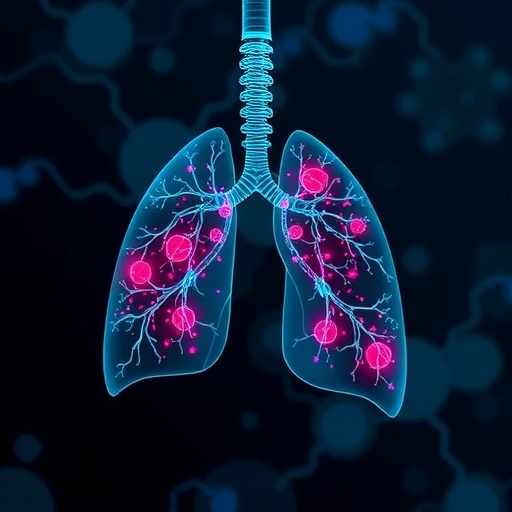In a groundbreaking study poised to reshape our understanding of lung cancer therapeutics, researchers have unveiled compelling evidence that derivatives of artemisinin—a drug class originally celebrated for its anti-malarial properties—exert distinctive effects on cell death pathways across different lung cancer subtypes. This research, led by Mölleken, Kragl, Monecke, and colleagues, delves deep into the intricate molecular interactions governing ferroptosis, a regulated form of cell death, by focusing on the modulation of GPX4, a pivotal antioxidant enzyme. Their investigation utilized patient-derived tissue cultures to bring unprecedented clinical relevance and precision to their findings, heralding new avenues for tailored lung cancer treatments.
Lung cancer remains one of the deadliest malignancies worldwide, with survival rates stagnating despite advances in chemotherapy, targeted therapy, and immunotherapy. Novel strategies targeting specific vulnerabilities of cancer cells are urgently needed. Artemisinin derivatives, originally extracted from the sweet wormwood plant, have sparked interest for their potent cytotoxic effects beyond malaria, demonstrated in variety of cancers. However, the mechanistic underpinnings of how these compounds induce cell death in lung cancer have been elusive—until now.
The team’s research dissected the biochemical influence of artemisinin derivatives on ferroptosis, an iron-dependent, lipid peroxidation-driven mode of cell death increasingly recognized as a therapeutic target in oncology. By regulating GPX4 (glutathione peroxidase 4), which protects cells from oxidative damage by reducing lipid hydroperoxides, these derivatives appear to manipulate the balance between survival and death in cancer cells. Crucially, the study revealed that the impact of artemisinin-based treatment varies significantly across lung cancer subtypes, underscoring the heterogeneity and complexity embedded within this disease.
.adsslot_SV6fDE0Or4{ width:728px !important; height:90px !important; }
@media (max-width:1199px) { .adsslot_SV6fDE0Or4{ width:468px !important; height:60px !important; } }
@media (max-width:767px) { .adsslot_SV6fDE0Or4{ width:320px !important; height:50px !important; } }
ADVERTISEMENT
At the heart of the study lies the enzyme GPX4, a master regulator mitigating ferroptotic cell death by countering lipid peroxidation. Downregulation or inhibition of GPX4 tips the redox homeostasis toward lethal accumulation of peroxidized lipids, selectively killing cancer cells while sparing normal tissue. The research demonstrated that artemisinin derivatives induce variable modulation of GPX4 depending on the lung cancer subtype, a finding that could inform future strategies to sensitize resistant tumors to ferroptosis inducers.
Intriguingly, the work uncovered that not all artemisinin derivatives wield uniform effects—chemical modifications within this drug class alter their capacity to regulate GPX4 and trigger ferroptosis. This nuance raises the prospect of designing derivative-specific therapies tailored to maximize tumor killing while minimizing off-target cytotoxicity. Such a precision pharmacological approach could revolutionize lung cancer treatment landscapes in the near future.
Additionally, the researchers integrated advanced molecular profiling, confirming that artemisinin-induced changes in GPX4 expression coincided with shifts in lipid peroxidation biomarkers and iron metabolism pathways. These corroborative findings substantiate the mechanistic hypothesis that ferroptosis is the predominant mode of cell death invoked by these compounds in patient-derived samples, marking a significant leap toward translational relevance.
Beyond biochemical parameters, the study’s utilization of clinically relevant tissue cultures bridges the gap between laboratory discovery and patient applicability. Traditional cancer cell lines often fail to recapitulate the complexity and heterogeneity of tumors in patients, which hampers drug development. The application of patient-derived cultures not only enhances predictive accuracy for therapeutic responses but also opens possibilities for personalized medicine strategies grounded on individual tumor biology.
This research also spotlights the broader implications of ferroptosis modulation in cancer therapy. Ferroptosis induction circumvents resistance mechanisms that blunt apoptosis, the classical programmed cell death pathway exploited by many drugs. By harnessing ferroptosis, artemisinin derivatives could overcome refractory disease states, a tantalizing prospect amidst the persistent challenge of therapy-resistant lung cancer.
Further exploration will be necessary to translate these findings into clinical protocols, encompassing dosing schemas, combinational regimens, and toxicity profiling. Nonetheless, the molecular insights gained provide a strong rationale for advancing artemisinin derivatives into early-phase clinical trials targeting specific lung cancer subtypes. Enhanced understanding of GPX4 regulation might also catalyze the discovery of novel biomarkers predicting treatment efficacy.
The study’s publication in Cell Death Discovery marks a milestone in cancer pharmacology, expanding the pharmacodynamic repertoire of artemisinin derivatives and illustrating the nuanced interplay between drug chemistry and tumor biology. Given the global burden of lung cancer, these findings could eventually impact millions by fostering more effective, individualized treatment options grounded in ferroptosis biology.
Encouragingly, the data support synergistic potential when combining artemisinin derivatives with other agents targeting complementary pathways, such as iron metabolism modulators or glutathione biosynthesis inhibitors. This polypharmacological strategy could amplify cancer cell vulnerability and mitigate resistance, reinforcing the therapeutic paradigm shift toward multifaceted ferroptosis-centered regimens.
Moreover, the exploration of artemisinin compounds nullifies the old assumption that a drug originally purposed for infectious disease cannot be repurposed successfully in oncology. Their structural versatility and ability to engage multiple cell death pathways spotlight these derivatives as a class of drugs with remarkable translational versatility and clinical potential.
The researchers emphasize that continued investigation is crucial to unravel the detailed molecular cascades linking artemisinin-induced oxidative stress, GPX4 inhibition, and ferroptotic cell demise. Such studies could also identify patient populations most likely to benefit, refining stratification for clinical trials. Personalized medicine stands to gain enormously from these targeted insights.
In conclusion, this landmark study offers a vivid demonstration that artemisinin derivatives wield subtype-specific control over lung cancer cell fate by precisely manipulating GPX4 and ferroptosis. Patient-derived tissue cultures have been instrumental in validating these effects in a clinically relevant context, heralding a strategic shift in lung cancer therapeutics towards ferroptosis modulation. As cancer research accelerates, the therapeutic horizons inspired by this work beckon with real promise for patients confronting lung malignancies.
Subject of Research: Artemisinin derivatives and their effect on cell death mechanisms, specifically ferroptosis via GPX4 regulation, in lung cancer subtypes.
Article Title: Artemisinin derivatives differently affect cell death of lung cancer subtypes by regulating GPX4 in patient-derived tissue cultures.
Article References:
Mölleken, J., Kragl, A., Monecke, A. et al. Artemisinin derivatives differently affect cell death of lung cancer subtypes by regulating GPX4 in patient-derived tissue cultures. Cell Death Discov. 11, 256 (2025). https://doi.org/10.1038/s41420-025-02537-2
Image Credits: AI Generated
DOI: https://doi.org/10.1038/s41420-025-02537-2
Tags: anti-cancer properties of artemisininArtemisinin derivativesbiochemical influence on lung cancercell death pathwayscytotoxic effects of artemisininferroptosis in cancerGPX4 modulationiron-dependent cell deathlung cancer therapeuticsnovel cancer treatment strategiespatient-derived tissue culturestargeted lung cancer therapies





